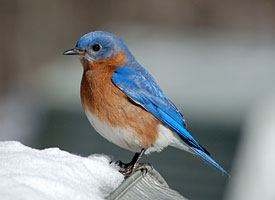Get answers to all your Bluebird questions!
Where do Bluebirds live?
 That depends on the species. There are three different families of Bluebirds living in North America: Eastern, Mountain and Western Bluebirds. The Eastern Bluebird lives anywhere East of the Rocky Mountains, from Southern Canada all the way into Mexico. The Mountain Bluebird lives primarily in the western United States and Canada. The Western Bluebird lives, as you may guess, in the western United States.
That depends on the species. There are three different families of Bluebirds living in North America: Eastern, Mountain and Western Bluebirds. The Eastern Bluebird lives anywhere East of the Rocky Mountains, from Southern Canada all the way into Mexico. The Mountain Bluebird lives primarily in the western United States and Canada. The Western Bluebird lives, as you may guess, in the western United States.
What do Bluebirds prefer to eat?
Bluebirds can be trained to use a seed feeder. However, they naturally eat insect larva and are particularly partial to mealworms. Choose a mealworm feeder to easily attract bluebirds or, for less maintenance, use our guide to training Bluebirds to use a seed feeder.
Why are Bluebird boxes so important?
The Bluebird population has declined drastically over the last 50 years. The introduction of House Sparrows and European Starlings, which are predatory to baby bluebirds, is responsible for this decline. However, vast destruction of their natural habitats is also to blame.
Today, the Bluebird population is largely dependant on birders and wildlife conservationists providing nesting boxes, supplies and food.
Where should I put my Bluebird house?
Bluebird houses should be kept at least 30 yards away from trees or large bushes. This helps protect the little birds from predators. Keep the nesting boxes away from water and around 100 yards apart.
How should I clean the Bluebird box?
Use a putty knife and a paint brush or pick up a set of birdhouse cleaning tools to clean debris and the old nesting materials away. Clean the nesting box after every nesting cycle. Once all materials are removed, spray a solution of one part bleach to 10 parts water into the box, allow it to dry, and wipe out a final time.
Do Bluebirds migrate?
Sometimes. Many Bluebirds go south for the winter, but if you are supplying them with mealworm or suet for the winter, they may stay and use the nesting box for shelter from the cold. If Bluebirds do stay in your yard during the winter months, it is essential that you keep up with feeding them. Their natural food, mostly insect larva, is largely unavailable in harsh winter months.
What color are bluebird eggs?
Almost all Bluebird eggs are blue. A few–around 5%–will be white.
Will other birds nest in my Bluebird House?
Yes. Many species, such as Wrens, House Swallows and the aggressive House Sparrow will use a Bluebird House. House Sparrows are the most likely to take over the nesting box. This is why keeping yours away from water is so important.
What is a Bluebird Trail?
Bluebird Trails are unique conservation attempts made to help the Bluebird population thrive. A trail is five or more Bluebird Houses placed over a large and open habitat area. The nesting boxes are organized this way to give multiple Bluebird families a place to thrive. Trails are often made with a cooperative effort by a whole community or a group of like-minded neighbors (Read more about Bluebird Trails).
What does the Bluebird nesting cycle look like?
Bluebirds nest in the Spring, which will be at a slightly different time, depending what part of North America you live in. Nests are typically built over the course of 10 days and made in cup shape of grass and pine needles. Next, eggs are laid and incubated for around two weeks by the female. Then, both parents will feed the nestlings in the birdhouse for 16-21 days. Finally, the baby bluebirds will move outside the nest for three or four more weeks before becoming completely independent.
In warmer climates, with a long Spring, Bluebirds will often complete two nesting cycles per season. The female then re-nests while the male takes over responsibility for the care of the first hatchlings.

